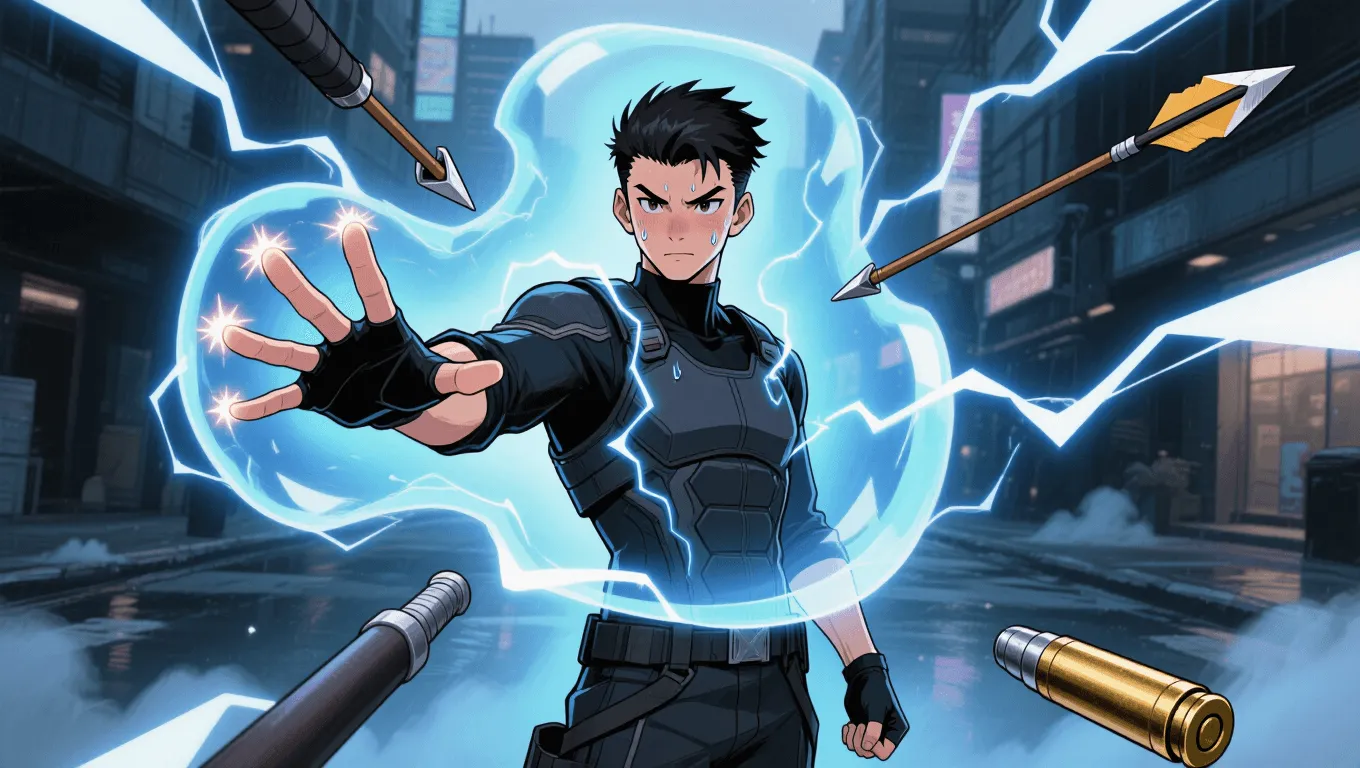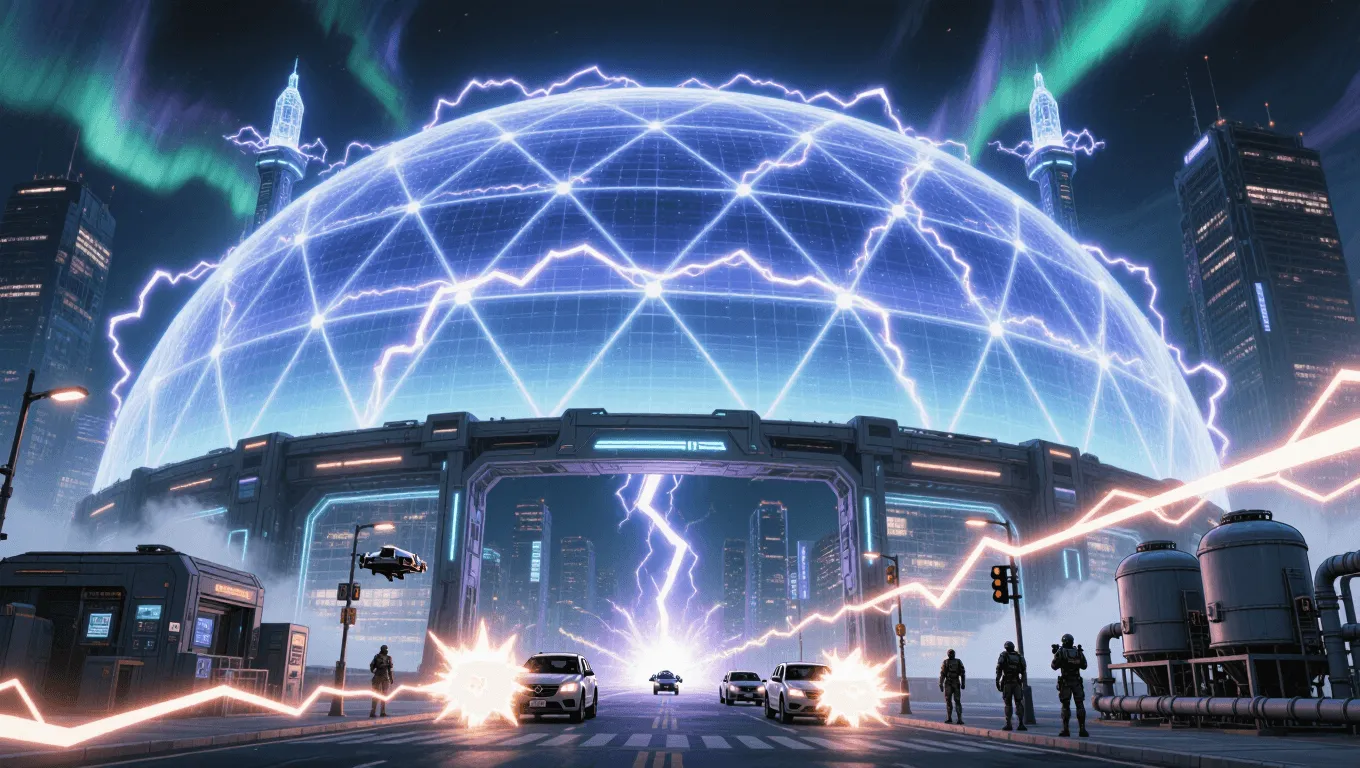Electric Shield (Superpower Guide)

Electric Shield Video Demo 🎬
Table of Contents
Electric Shield is a defensive superpower that forms a protective barrier made of controlled electricity around the user or an ally. In simple terms, it’s a mobile Faraday cage and energy field rolled into one: it blocks or deflects physical attacks, disperses incoming energy, and shocks anything that tries to break through. On this page, readers will find what Electric Shield is, how it works in battle, how it scales by level, its limitations, weaknesses, synergy picks, and famous users. For more abilities, browse the complete superpower list or spin a new idea with the random superpower generator.
What Is Electric Shield
Electric Shield is the generation and maintenance of a stable, shaped electrical field that functions as a barrier. Unlike general electrokinesis, which focuses on projecting bolts or manipulating current flow, this power specializes in defensive architecture: domes, bubbles, panels, and “skins” of ionized air and electromagnetic force. The field can:
-
Repel or disperse kinetic attacks by creating electromagnetic pressure and high-voltage boundary layers.
-
Short out or deflect conductive projectiles.
-
Neutralize certain energy attacks by diffusing charge or redirecting arcs to ground.
-
Deliver non-lethal or lethal shocks on contact, depending on voltage/amperage settings.
Advanced users can tune frequency, shape, thickness, capacitance, and polarity, enabling selective permeability (letting air and sound pass while blocking matter) or even turning the shield into a capacitive battery that stores and re-emits energy.
Core Abilities of Electric Shield
1) Reactive Electric Barrier
A semi-transparent field snaps up around the user when threats are detected. This “auto-parry” responds faster than reflexes, intercepting melee strikes, arrows, or low-caliber rounds. The edge of the field ionizes air, creating a crackling corona that warns attackers.
2) Shaped Field Geometry
Practitioners can sculpt the barrier as a sphere, dome, wall, or skin-tight suit. Domes provide all-around protection; panels are ideal for corridors; a “gauntlet” form can guard the forearm while leaving the other hand free to cast or wield.
3) Selective Permeability
With fine control, the user lets friendly objects or allies move through while rejecting hostile matter. Advanced tuning allows airflow for breathing, muffled sound transmission, or safe ejection of excess heat.
4) Shock-on-Contact
Anything contacting the field can be shocked. Settings range from stun-level taser outputs (non-lethal) to disabling jolts against powered armor, drones, and synthetic foes. This makes the shield double as crowd control.
5) Arc Redirection & Grounding
The shield acts like a smart Faraday cage, catching stray lightning, lasers with conductive housings, or energized weapons and directing the energy to a safe ground or to a storage layer for later discharge.
6) Electromagnetic Interference (EMI) Veil
A tuned Electric Shield can scramble or attenuate radio frequencies, basic sensors, and certain targeting systems within close range. Stealthy versions damp signatures instead of broadcasting an obvious corona.
7) Capacitive Storage & Burst
By temporarily storing charge in layered fields, the user can release a controlled EMP-style pulse or a focused arc lash without dropping the barrier fully—essential for “block-then-counter” sequences.
8) Team Coverage & Relay
Skilled users can blanket small squads or link multiple panels into a larger phalanx, creating corridors of safety or mobile cover for evacuations, medics, or heavy-weapons setups.
Application / Tactical Advantages in Combat
-
Projectile Defense: Against bullets and shrapnel, the shield dissipates kinetic energy via electromagnetic pressure and controlled arcing. Conductive rounds may deform, heat, or arc away.
-
Energy Mitigation: Plasma, lightning, and certain beam weapons suffer diffusion or redirection. The shield’s tuned frequency spreads incoming energy over a large surface area to minimize penetration.
-
Melee Disruption: Blades, batons, and claws risk shock feedback. The shield’s boundary layer makes grapples difficult, punishing close-range aggression.
-
Area Denial: By extending a panel or dome, the user can cut off doorways, stairwells, or street chokepoints. Stun settings deter rushdowns without lethal force.
-
Counter-Hacking of Tech Foes: EMI from the field interferes with drones, guided munitions, and HUDs. A quick pulse can desync cheap electronics or overload unshielded circuitry.
-
Safe Advance & Extraction: Teams can move under the shield like an “electric umbrella,” facilitating rescues, breaching operations, and retreats under fire.
-
Environmental Control: The field can repel sparks, embers, or toxic particulates at the perimeter, buying time against environmental hazards.
-
Energy Recycling: Absorbed electrical attacks can be re-routed into stored charge, turning enemy fire into fuel.
Level: Level 1 🏙️, Level 2 🌇, Level 3 🌃
Level 1
-
Coverage: One-person bubble or torso-high panel for ~10–20 seconds of sustained protection.
-
Stopping Power: Effective versus melee, arrows, thrown weapons, and limited small-arms fire (handguns).
-
Control: Basic on/off, minimal shaping; contact shocks limited to stun-level outputs.
-
Drawbacks: Significant fatigue after continuous use; audible crackle gives away position; poor performance in heavy rain or on soaked terrain without grounding practice.

Level 2
-
Coverage: Two to five people under a dome, or multiple interlinked panels providing 120–180 degrees of coverage.
-
Stopping Power: Resistant to most small arms and some rifle rounds; able to diffuse low-grade energy blasts and redirect lightning strikes.
-
Control: Tuning for selective permeability; short-range EMI dampening; capacitive “block-then-burst” counter.
-
Utilities: Can shape barriers around moving vehicles at moderate speeds; forms short-lived corridors for evacuations.
-
Drawbacks: Noticeable heat buildup; extended operation induces dehydration and muscle tremors; electronics on the user may suffer interference without hardened housings.

Level 3
-
Coverage: Building or street-block domes; multi-layered fields with redundant lattices.
-
Stopping Power: Withstands sustained rifle fire, explosives at moderate standoff, and advanced energy weapons.
-
Control: Precision frequency tuning, selective gateways, remote “relay nodes,” and dynamic thickness control (bulking up against heavy hits).
-
Utilities: Can emit directional EMP-like pulses while maintaining core shielding; can store and redirect significant charge into tactical lightning lashes.
-
Drawbacks: Massive energy and hydration requirements; thermal management becomes critical; visible aurora-like effects make stealth almost impossible; extended operation risks cardiac strain without conditioning.

Limitations of Using the Electric Shield
-
Power Drain & Stamina: Maintaining voltage, field stability, and shape control is exhausting. Long fights require breaks or external power sources.
-
Thermal Buildup: Even as it stops attacks, the shield absorbs heat. Without vents or selective permeability, the user risks heat stress.
-
Environmental Conductivity: Heavy rain, flooded floors, or conductive debris can diffuse the field’s edge, creating unintended current paths and friendly-fire risk.
-
Line-of-Sight & Mobility: Large domes obstruct visibility; sprinting with maximum coverage reduces acceleration and agility.
-
Collateral EMI: Radios, medical devices, and friendly drones may glitch near the shield unless hardened.
-
Tuning Complexity: Selective permeability demands fine control. A mistuned field can block air exchange, trap smoke, or let microprojectiles through.
-
Grounding Dependency: Without a reliable ground or storage sink, excess charge lingers and can arc at the wrong moment.
Weakness Against What Other Superpowers
-
Earth Manipulation / Geokinesis: Grounding spikes and conductive earthworks can wick charge away, weakening the barrier’s edge or anchoring it in place.
-
Insulation & Dielectric Fields: Powers that generate non-conductive barriers (e.g., silica shells, ceramic armor, pure force fields) resist shock transfers and reduce arc options.
-
Hydrokinesis & Weather Control: Torrential rain, dense fog, or water curtains spread and drain the field’s boundary, increasing energy costs and risking shorts.
-
Energy Nullification / Dampening: Any anti-power field that collapses electromagnetic phenomena can flicker or drop Electric Shield outright.
-
Sonic/Vibration Attacks: Pressure waves can couple through air if the shield isn’t tuned to block or phase them, stunning the user inside.
-
Telepathy / Illusion: Non-physical threats bypass the barrier; the user needs mental defenses or sensors.
-
Precision Magnetism: Magnetokinesis can distort the field’s geometry, prying open gaps or twisting arcs toward allies.
Synergistic Power Combos
-
Electrokinesis: Pairing offensive lightning with Electric Shield creates perfect “turtle-and-strike” loops—absorb, store, then lash out while still covered.
-
Magnetokinesis: Magnetic shaping stabilizes field lattices and curves incoming metal projectiles around the dome like a rail.
-
Force-Field Generation: Stacking a neutral force field beneath the Electric Shield solves dielectric weaknesses and blocks sonic coupling.
-
Metal Manipulation / Ferrokinesis: On-the-fly Faraday cages and grounded pylons supercharge safety, letting the user run higher voltages without friendly-fire.
-
Aerokinesis: Ionizing airflows sharpen shield boundaries and vent heat; micro-wind tunnels preserve breathable air inside large domes.
-
Speedster Allies: A sprinter can bait fire, retreat under the dome, and slingshot out during the counter-burst, maximizing tempo control.
-
Tech Augmentation: Battery packs, supercapacitors, or wearable radiators extend uptime and allow silent “EMI-low” modes for stealthy operations.
Known Users
-
Static (DC Comics) — Often depicted manipulating electrostatic forces into defensive barriers and hover discs; a strong example of field shaping and non-lethal shock tactics.
-
Livewire (DC Comics) — A classic electricity wielder who periodically employs protective electric fields while channeling high-voltage attacks.
-
Electro (Marvel Comics) — Primarily offensive, but many portrayals show him insulating himself with charged auras that deter melee engagement.
Explore more power profiles in the Superpower Wiki, or let fate pick your next idea with the random superpower generator.
